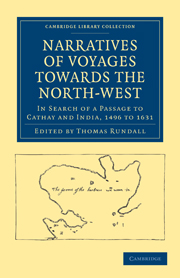 Narratives of Voyages Towards the North-West, in Search of a Passage to Cathay and India, 1496 to 1631
Narratives of Voyages Towards the North-West, in Search of a Passage to Cathay and India, 1496 to 1631 Introduction
Published online by Cambridge University Press: 05 October 2010
Summary
Before entering on the narratives of the voyages undertaken for the discovery of the North-west passage, some observations will be offered on two points connected with the general subject of North-polar researches, viz.: i. The claims of Sir Hugh Willoughby to be considered a discoverer; and, ii. The probability of an Englishman, named William Adams, having made a voyage to Spitsbergen, a.d. 1595.
Of the Claims of Sir Hugh Willoughby to be considered a Discoverer
By injudicious advocacy on one hand, and by careless oversight, or wilful neglect, on the other hand, the reputation of Sir Hugh Willoughby is at present left to the mercy of conjecture. One authority has laboured to prove him to be entitled to the merit of a particular discovery. Another authority peremptorily denies the validity of the grounds on which the claim is made on his behalf. Neither takes any pains to ascertain whether he is entitled to distinction for any other service than the one particularized.
It is Purchas who claims the merit of a particular discovery for Sir Hugh Willoughby. Purchas states, that in his progress towards the North-east, the navigator was driven to the height of 72°, where he fell in with an island which is designated Willoughby Land, lying in a particular direction, and at a specified distance from a place named Seynam. “From thence”, it is said, he proceeded in a certain direction, saw certain lands, and finally cast anchor in a certain locality: which is described, and to which the following remark is applied; “And this is the land which is now colled Greenland, or King James his New Land, and is known to the Hollanders by the name of Spitzbergen”.
- Type
- Chapter
- Information
- Narratives of Voyages Towards the North-West, in Search of a Passage to Cathay and India, 1496 to 1631With Selections from the Early Records of the Honourable the East India Company and from Mss. in the British Museum, pp. i - xxPublisher: Cambridge University PressPrint publication year: 2010First published in: 1849
